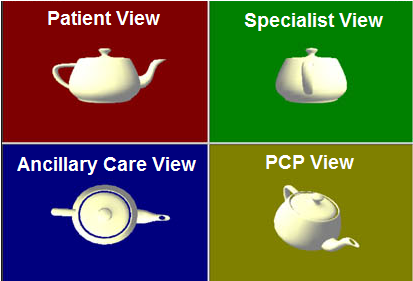Multiple Content Views
The Multiple Content Views profile provides guidance on how text in CDA documents may be tagged to achieve different rendering behaviors.
Summary
The Multiple Content Views profile guidance on how text in CDA documents may be tagged to achieve different rendering behaviors allows one document to serve different needs based upon the requirements of the person viewing the document. For example, the viewing requirements of a patient differ from the requirements of a healthcare provider. The profile identifies many of the requirements expressed by patients, classifies these requirements, identifies the rendering behavior associated with each, and provides guidance on how to tag CDA content in order to bind it to an identified behavior. Use of this profile allows one CDA document to serve the needs of different Document Consumers.
Benefits
The profile allows one CDA document to serve the needs of different Document Consumers by providing the ability for one document to serve different needs based upon the requirements of the person viewing the document. For example, the viewing requirements of a patient differ from the requirements of a healthcare provider. The profile identifies many of the requirements expressed by patients, classifies these requirements, identifies the rendering behavior associated with each, and provides guidance on how to tag CDA content in order to bind it to an identified behavior.
Details
CDA documents contain data and details based upon various profiles and implementation guides. Representation and rendering of this data changes based upon different needs and audiences. Patients, providers and even systems each have different requirements for the content and rendering of the content in exported documents.
Various end users viewing CDA content are interested in specific portions of the available content and may not have immediate need to access other portions of the content. In order to streamline their workflows, there is a desire to be able to semantically identify narrative content in such a way as to allow customized user views to be implemented systematically between systems producing and consuming documents.
Systems Affected
<List (in user terms) the types of systems they might expect to have implemented actors from this profile, e.g. RIS, PACS, HIS, CAD Workstation, etc. and for each, how it would participate.>
Actors & Transactions:
Specification
Profile Status: Final Text <Replace "Final Text" with "Trial Implementation" or "Public Comment" as appropriate.>
Documents:
<Provide direct links to the specific volumes or supplements, and list the volume sections relevant to this profile. This is a simple inventory of official normative and informative text. If you would like to provide a reading guide or walkthrough of what is in each of the different sections for implementers or users, do that in the Profile FAQ or the Profile Implementation Page linked below. If the profile uses transactions from multiple Tech. Frameworks, repeat the structure below.>
Underlying Standards:
<list all the standards on which the profile is based; if possible with links to sources>
See Also
<The following sections can be left out if there is nothing to point to. This is just to show where such information can go.>
Related Profiles
<List profiles this one depends on, profiles that depend on this one, profiles that are synergistic with this one. Start with the name of the other profile as a link and then explain the relationship.>
Consumer Information
The Profile FAQ Template answers typical questions about what the Profile does. <Replace the link with a link to the actual FAQ page for the Profile>
The Profile Purchasing Template describes considerations when purchasing equipment to deploy this Profile. <Replace the link with a link to the actual Purchasing page for the Profile>
Implementer Information
The Profile Implementation Template provides additional information about implementing this Profile in software. <Replace the link with a link to the actual Implementation page for the Profile>
Reference Articles
<List References (good and bad) (with link if possible) to Journal Articles that mention IHE's work (and hopefully include some analysis). Go ahead, Google: IHE <Profile Name> abstract or Google: IHE <Profile Name> and under the "more" select "Scholar". You might be surprised. >
This page is based on the Profile Overview Template

